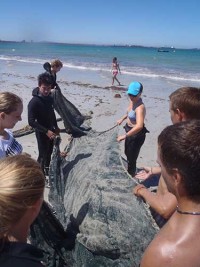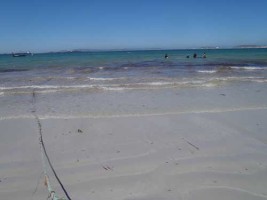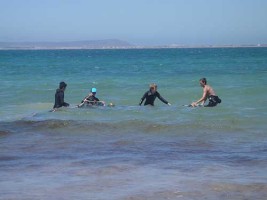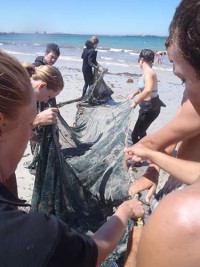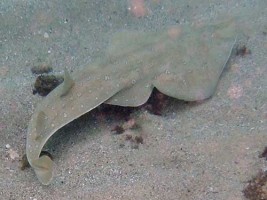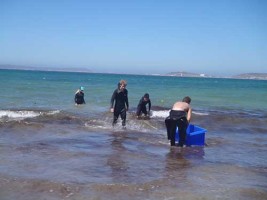During my final day in Cape Town I got the chance to join in with some data collection for a masters student at the University of Cape Town. I love fieldwork, especially when it involves being in, on or around the sea. When Steve Benjamin of Animal Ocean – a marine adventure company based near Cape Town – got in touch to ask if I wanted to help catch Lesser Sandshark/Guitarfish (Rhinobatos annulatus) along the western cape coastline I immediately said yes.
Also helping was a group of students from Gap South Africa. When the data collection got into full swing I was glad we had plenty of people on hand as it required some hard graft. After an hour drive along the scenic western cape we made it to the sheltered bay that was to be our data collection site. After lugging the seine net – which we would be using to catch the sharks – down to the shore we were briefed and quickly set to work.
Four of us took to the water in our wetsuits to help deploy the net along the shore, while the others stayed on-shore to pull in the net. The net must have been at least 20m long and considering it was scooping up everything in its path it could get pretty heavy. In the end we all had to run back on-shore to help pull the net it and once it was out we would inspecting its contents. We had to pick through heaps of seaweed in an attempt to find two species of fish that were also needed for research. The sand sharks were a bit more obvious and were picked out of the net with ease.
These sharks/guitarfish, live in sheltered bays in the subtropical regions of the world. I was amazed at how close to shore these sharks were and we only needed to deploy the net approximately 10m out from shore in order to catch them. The IUCN do not consider the Lesser Sandshark a threatened species and it is the most abundant guitarfish in the sub-equatorial African region.
Although it is not a threatened species, learning more about this species is of great importance. The fact that it is not threatened allows researchers to collect the sharks for their research, providing extremely valuable information about their life patterns, behaviour and population dynamics. In doing so they can gain information that will help ensure this animal remains unthreatened.
In total we managed to deploy the net enough times to collect 11 sharks and by the final haul our muscles were burning. It was a really enjoyable day and a chance for me to learn more about postgraduate study. I am still in two minds about whether or not I will go on to do further study, but one thing I do know is that I enjoy getting my hands dirty and being out in the field.
